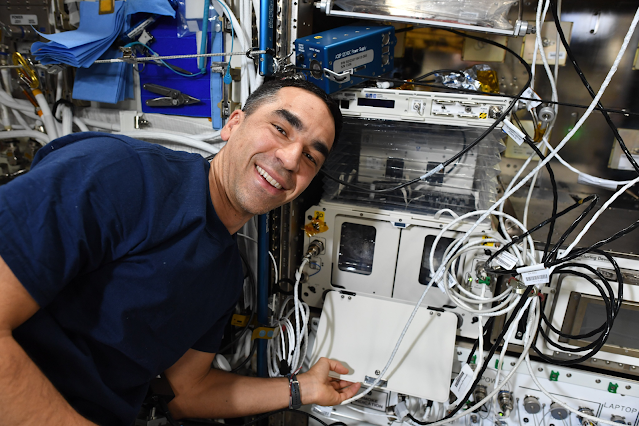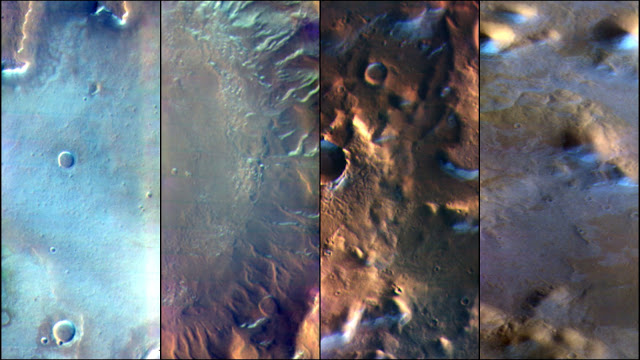ISS - Expedition 67 Mission patch.
May 6, 2022
Image above: NASA astronaut Jessica Watkins floats in the space station’s cupola, a direct nadir viewing window from which Earth and celestial objects are visible. Crew members often spend free time here taking in the spectacular views. Image Credit: NASA.
Crew members aboard the International Space Station conducted scientific investigations during the week of May 2 that included demonstrating autonomous robotic technology, testing liquid- and air-based systems for growing plants, and examining the effects of microgravity on grip strength and upper limb movement. The SpaceX Crew-3 mission, NASA astronauts Raja Chari, Tom Marshburn, and Kayla Barron and ESA (European Space Agency) astronaut Matthias Maurer, splashed down on Friday, ending their nearly six-month mission.
Here are details on some of these investigations aboard the microgravity lab:
Robotic caretakers
Image above: NASA astronauts Kayla Barron (left) and Jessica Watkins (right) and ESA astronaut Samantha Cristoforetti (top) work checking out systems inside the International Space Station's Kibo laboratory module. Image Credit: NASA.
During human exploration in deep space, infrastructure such as Gateway may be without crew for extended periods. ISAAC demonstrates technology for using autonomous robots to track the health of this infrastructure, provide maintenance, and respond to critical faults such as leaks and fires when crew members are away. The technology also could enable robotic transfer and unpacking of cargo in preparation of the arrival of crew members. The investigation uses the Astrobee robots already aboard the space station. This technology also could provide autonomous caretaking of industrial or research facilities on Earth where continuous human presence is costly or dangerous, such as polar bases and oceanic research vessels. ISAAC is led by the NASA Ames Research Center Intelligent Robotics Group in collaboration with the Johnson Space Center Robotic Systems Technology Branch. During the week, crew members activated Astrobee robots for the demonstration.
New ways to grow
Image above: NASA astronaut Raja Chari works on the XROOTS investigation, which tests techniques to grow plants without soil or other traditional growth media. Image Credit: NASA.
XROOTS uses hydroponic (liquid-based) and aeroponic (air-based) techniques to grow plants without soil or other traditional growth media. Current space-based plant systems are small, and their water and nutrient delivery systems do not scale well for longer spaceflight due to issues such as mass, containment, maintenance, and sanitation. Hydroponic and aeroponic techniques could enable production of crops on a larger scale for future space exploration. Growth system components developed for this investigation also could enhance cultivation of plants in terrestrial settings such as greenhouses, contributing to better food security for people on Earth. Crew members conducted checks of the investigation facility and installed plants during the week.
Manipulation in microgravity
Animation above: NASA astronaut Robert Hines conducts a seated session for the ESA GRIP investigation, which studies how long-duration spaceflight affects grip force and arm movements when a person manipulates objects. Animation Credit: NASA.
GRIP, an investigation from ESA, studies the effects of long-duration spaceflight on a person’s ability to regulate the force of their grip and trajectories of upper limbs while manipulating objects. Changes in these functions, which developed in Earth’s gravity, have been observed during short-term exposure to microgravity. Results of this investigation could identify potential hazards for astronauts as they move between gravitational environments and contribute to the design and control of equipment and systems used on future exploration missions. This experiment also could contribute to a better understanding of how the human nervous system controls movement on the ground. During the week, crew members performed seated and supine sessions for the investigation.
Other investigations involving the crew:
- Phospho-aging, an investigation from the Japan Aerospace Exploration Agency (JAXA), examines the molecular mechanism behind aging-like symptoms, such as bone and muscle loss, that can occur more rapidly in microgravity. Results could provide evidence that bone loss experienced on Earth actually is a cause and not only a symptom of aging and preventing such loss could be a practical anti-aging therapy contributing to longer healthy life spans in humans.
https://www.nasa.gov/mission_pages/station/research/experiments/explorer/Investigation.html?#id=8278
- DOSIS-3D, an investigation from ESA, measures the radiation doses at specific locations inside the space station to create a three-dimensional map of the levels and distribution of radiation throughout the orbiting lab. Results could help scientists make recommendations for how to protect crews on future missions.
https://www.nasa.gov/mission_pages/station/research/experiments/explorer/Investigation.html?#id=177
- The ESA NutrISS investigation assesses changes in an individual’s body composition and energy balance throughout spaceflight. Results could provide insight into what causes these changes and lead to ways to improve physical health and quality of life for astronauts during and after their flight.
https://www.nasa.gov/mission_pages/station/research/experiments/explorer/Investigation.html?#id=7875
- Transparent Alloys - METCOMP, an investigation from ESA, studies the formation of layered structures during solidification of an alloy (a mixture of different metals) using specific organic materials that solidify like a metal yet remain transparent. Alloys are used in a wide variety of applications from smartphones to aircraft, and lighter, stronger versions could benefit consumers and industry.
https://www.nasa.gov/mission_pages/station/research/experiments/explorer/Investigation.html?#id=8504
- Wireless Compose-2, an investigation from ESA, demonstrates a wireless network infrastructure for sensor monitoring and data transmission to support scientific experiments in microgravity. Results could contribute to development of new technologies for monitoring the health of astronauts and people on the ground and hardware that provides more precise control of free-flying robots.
https://www.nasa.gov/mission_pages/station/research/experiments/explorer/Investigation.html?#id=8563
- Rhodium Crystal Preservation studies the use of crystal formation to preserve biological material for research. These crystal matrices do not require special conditions and could provide a way to maintain biological materials for research on future space missions.
https://www.nasa.gov/mission_pages/station/research/experiments/explorer/Investigation.html?#id=8712
- Actiwatch is a wearable monitor that continuously collects data on a crew member’s circadian rhythms, sleep-wake patterns, and activity during flight.
https://www.nasa.gov/mission_pages/station/research/experiments/explorer/Facility.html?#id=838
Space to Ground: Place of No Return: 05/06/2022
Related links:
Expedition 67: https://www.nasa.gov/mission_pages/station/expeditions/expedition67/index.html
Gateway: https://www.nasa.gov/gateway
ISAAC: https://www.nasa.gov/mission_pages/station/research/experiments/explorer/Investigation.html?#id=8427
Astrobee: https://www.nasa.gov/mission_pages/station/research/experiments/explorer/Facility.html?#id=1891
XROOTS: https://www.nasa.gov/mission_pages/station/research/experiments/explorer/Investigation.html?#id=8088
GRIP: https://www.nasa.gov/mission_pages/station/research/experiments/explorer/Investigation.html?#id=1188
ISS National Lab: https://www.issnationallab.org/
Spot the Station: https://spotthestation.nasa.gov/
Space Station Research and Technology: https://www.nasa.gov/mission_pages/station/research/overview.html
International Space Station (ISS): https://www.nasa.gov/mission_pages/station/main/index.html
Images (mentioned), Animation (mentioned), Video (NASA), Text, Credits: NASA/Ana Guzman/John Love, ISS Research Planning Integration Scientist Expedition 67.
Greetings, Orbiter.ch










.jpg)

































